Why is the ability to measure genes and protein expression simultaneously beneficial for researchers in the field of cancer immunology?
Cancer immunology is all about how your immune cells are going to fight and kill your tumor cells. If you look at the pure genetic code of a T-cell that's going to kill your tumor compared to the same cell that has been “put-to-sleep” (by the tumor), the pure genetic DNA content of those two cells are identical.
Essentially, they really aren't any different at all, which means that if all you’re going to do is look at the DNA sequence, that won’t provide you with enough information to know which cells are going to kill and attack a cell and which ones are not.
You then ask yourself “What’s different between the two states of the T-cell”, and what you find is that there has been a big change in transcriptional programming; the mRNA changes generate new proteins that alter the cell surface proteins that interact (and can kill) the tumor cell. That's just one particular example, where the DNA doesn't contain all the information you need, but where the mRNA and the proteins perhaps do.
There are many examples. It may be the case that the DNA has the right information and the protein or mRNA don't matter. There's almost every combination of DNA, RNA and Protein containing the essential information, all depending on what problem you're solving.
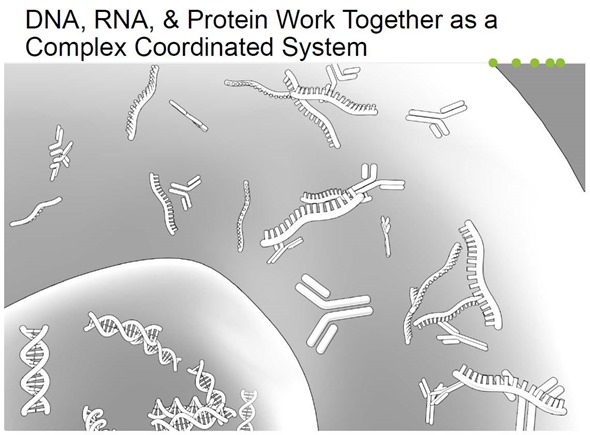
(c) 2016 NanoString Technologies, Inc.
The most general solution is to take information from the DNA level, mRNA level and protein level and query it simultaneously whenever you want because that guarantees you’ll have all the information that's required to interrogate these systems.
That's one of the reasons there's been so much excitement about 3D Biology™ in the area of immuno-oncology. We've lived in a drug development world where basically the drugs treat a SNP ((single nucleotide polymorphism — i.e., a single mutation) in the DNA. But, the fact is that targeted medicines don't always work.
If the tumor escapes your targeted therapy, then you're right back to where you started. You solve one little thing and then something else shows up.
Immuno-oncology works on a totally different principal. It's not a case of chasing SNPs around anymore; you have to look further downstream to see how the body is responding and that's why you need to have the mRNA and the protein signals.
What is 3D Biology™ technology?
3D Biology is about the ability to measure simultaneously, on a single system, any combination of DNA, RNA and proteins.
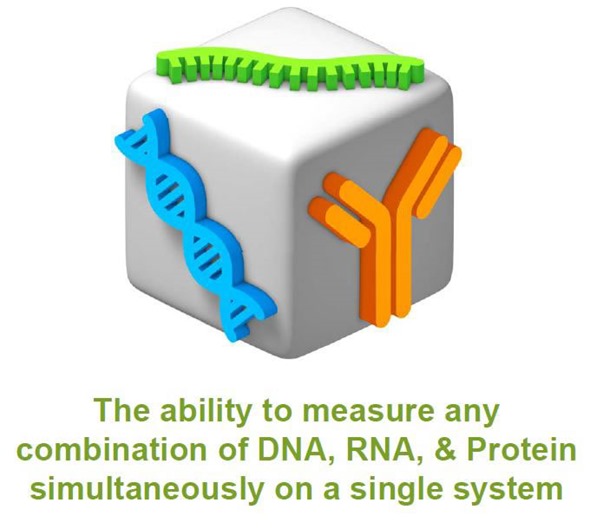
(c) 2016 NanoString Technologies, Inc.
The 3D part refers to 3 dimensions of data; one dimension DNA, another RNA and the third proteins. We've designed it so that you can have any combination of those data.

(c) 2016 NanoString Technologies, Inc.
You don't need to have all three dimensions for every particular application; sometimes mRNA and protein work fine and sometimes the DNA and protein work fine. Any combination of those three is referred to as a 3D biology approach.
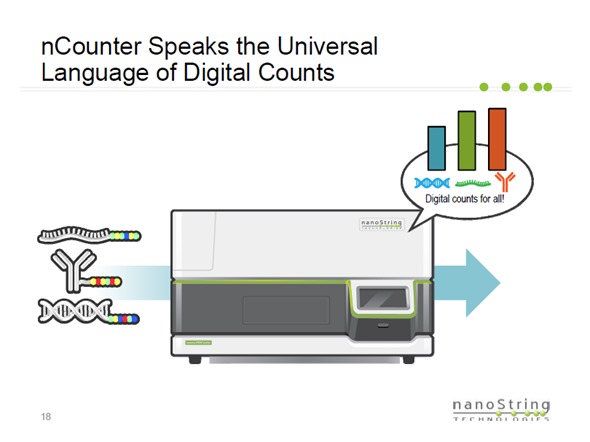
(c) 2016 NanoString Technologies, Inc.
nCounter SPRINT and nCounter MAX are for research use only. Not for use in diagnostic procedures.
What impact do you think 3D Biology technology will have on immuno-oncology biomarker discovery and utilization?
I think it's going to have a huge impact. In the field today, there exists some very useful signatures that are one dimensional. When you combine information in DNA, mRNA and proteins, the information content just doesn't escalate in a linear way, it escalates exponentially.
We have a lot of examples of people putting our tool into clinical trial programs for exploratory research where they're developing biomarkers. One tool that’s being used most right now is one that we came out with recently, and it's called the immune profiling panel.
It's a 770 Plex mRNA assay for profiling tumors. That's been out for about a year now, and it's starting to get regularly embedded in different clinical trial programs for exploratory research.
We just came from one of the biggest immunotherapy meetings of the year called SITC – Society for Immunotherapy and Cancer. There were 14 posters and presentations related to just our gene expression signatures being used for exploratory analyses in various immunotherapy clinical trials.
We reported on one study with a group called the CITN – the Cancer Immunotherapy Trial Network group. There was also a group from Providence Hospital, where Dr. Bernie Fox (and colleagues) reported on a phase II clinical trial that's related to head and neck cancer.
There’s a number of reports on using these signature tools now in immunotherapy clinical trials that actually discover the key biomarkers, which may be used for companion diagnostics and for diagnostic development.
The whole field is exploding and we're pretty much the only key signature biomarker group that's really way ahead of the curve in this particular space.

(c) 2016 NanoString Technologies, Inc.
Can you please outline the seven new gene expression panels NanoString Technologies have launched?
These are called profiling panels. These profiling panels support what I call the foundational panels. Foundational panels are the three sets of these gene expression panels, all 770- plexes.
The PanCancer pathway panel answers a cancer-cell specific question “what drives tumor growth”, the PanCancer Immune Profiling Panel answers “how the body responds to the presence of the tumor” and the PanCancer Progression Panel answers “how the tumor progresses.”
If you view these panels like a targeted discovery net, capturing key cancer biological features, they're very useful for targeted biomarker discovery in clinical (and research) samples. The PanCancer immune profiling panel, for biomarker discovery in Immuno-Oncology (i.e., IO) space, that's where you saw all this activity at all these recent immunotherapy meetings.
Those three 770 Plexes represent the broad net that you go fishing with. We make the panels 770-plex in order to reserve 30 barcodes for customers to custom-design (and “spike-in”) specific genes of unique interest.
The seven new panels are called “Vantage RNA” panels because they represent specific focus areas that are in our broad targeted discovery panels, but they go deeper into a single area.
For example, say you really like to fish for your favorite kind of trout and that type of trout is always hanging out in one part of the stream. We have developed fishing nets that actually focus on unique areas inside cancer where you may want to do some more fine fishing. That represents what we did with these cancer profiling panels.
To give you an idea of some of the fine fishing areas that we put out with these panels, one of the key areas of interest in immuno-oncology and immunotherapy is infiltrating cells – the immune cells that infiltrate a tumor.
There are different classes of cells that infiltrate a tumor, and with our PanCancer immune profiling, we can actually observe 24 different types. The cell- type profiling panel focuses on this single application and will provide a more robust cell-type power of resolution. This was such an important application; we devoted 192 genes just in that area.
We also took areas such as the innate immunity, which is like the early stages of the immune response. We generated a specific panel for that to focus on that area. The adaptive immune response is something that evolves a little bit later. This is all the adaption that happens that actually generates T-cells that can kill a tumor, and we have a focused area on that.
We have an area that's actually related to all the genes and how the genetic composition of your cells are being copied. This is called mismatched repair, DNA repair and micro-satellite instability. We have a special profile-panel “net” that generates a bunch of mutagens which make a tumor “hot,” from an immunological standpoint.
That's how the profile panels fit in. They support these detail focused areas that link in with our broader targeted discovery tools. We're going to continue to do this with continued releases in these focused areas. We think that provides a very nice combination, where somebody can go fishing with a broad net and if they find something interesting, then they can actually go fishing with these more focused tools.
These profiling panels also have a less expensive, cost per sample structure associated with them. Some researchers are not in a big pharmaceutical organization, for example; they may just be working with their own little (RO1) grant in a medical center or somewhere.
It may be more appropriate for them to fish with smaller profile panels and then use the larger panels for some very important data sets with which they explore. It's all about how to allow the entire broad research community to be able to access our tools.
Is it possible to customize the panels at all?
What we did to engineer customization into every panel is make our multiplexing go up to 800 genes and reserved 30 unique barcodes just for people's custom work. This allows them to take any of our great targeted discoveries.
But, let's say they know 30 things that nobody else in the entire world knows. We have a very simple way of actually custom designing assays into those reserved barcodes. They could add those to the larger panels and then it works like a custom panel. That's one of the things we did for both the profiling panels and the foundational panels.
The other thing to realize is that about half of our total work, all of our consumable reagents, are custom from scratch work. That's a normal part of our operating mechanism.
Any customer on the outside may love all the stuff we've done but they may have their own perfect panel that they've engineered within their pharmaceutical company. They may want us to make them from scratch – make 800 from scratch – and we absolutely do that.
All a person has to do is send us the gene lists associated with those custom target genes. We do all the bioinformatics design and all the custom synthesis. We make the reagents so that they all work together and we can supply that back to the customer within about four weeks. If they want us to make it totally from scratch, we do that and there's no extra charge associated with it.
If they want to utilize our panels, they can jump right in and do immediate experiments. They could be running a reagent that's off the shelf; they order it up and it comes to their lab the same week. If they want to do a custom design on top of that, they're allowed to. There are a lot of options for customization here. We have customers in groups that run all the way from full custom to full panel utilization and everything in between.
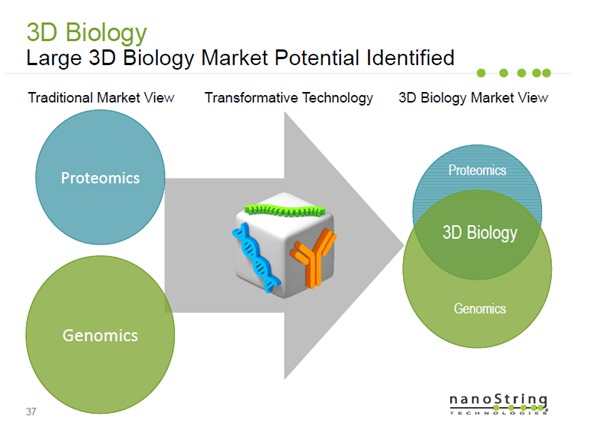
(c) 2016 NanoString Technologies, Inc.
What impact do you think the new Vantage RNA Panels will have?
Whenever you provide a new tool for the translational researcher to use, it's remarkable how inventive they are when utilizing these tools. We really work hard to make general purpose tools, and we never cease to be amazed at what is done with them.
We're coming up to approximately 900 peer reviewed papers now where these tools have been used. We almost have more than one peer reviewed paper show up every business day. It's just amazing the number of discoveries that are out there.
I think there's now around 40 to 60 special biomarker signatures discovered, all with peer reviewed articles published on them. These profiling panels and these targeted discovery panels are generating unique biomarker signatures at an incredible pace.
What you often find is that investigators that discover unique biomarker signatures on our system come back to us for more full clinical assay development (to be used on patient samples), because that's not really what these researchers are wired to do. An academic researcher is not really wired and set up to do full blown clinical assay development, so that content tends to come back to us.
Using our targeted discovery tools, customers routinely discover signatures completely on their own and then when it comes to doing clinical assay development, they come back to us and ask us if we can help actually translate it into a clinical grade assay. For Pharmaceutical companies, this allows them to focus on drug development and we do the companion diagnostic side.
We have multiple examples of that. Our Prosigna assay on breast cancer was developed that way. It was a signature developed by a consortium of four different medical centers. They developed it and then asked us to take it on and make a diagnostic out of it. We then licensed it from them and took it to the FDA and we're now FDA cleared on that assay.
We're going to see biomarker signatures as a result of these profile tools and a whole bunch of those biomarker signatures will come back to us for further clinical assay developments.

(c) 2016 NanoString Technologies, Inc.
Do you plan to develop any more gene expression panels?
Absolutely. There are discoveries made in this area of immuno-oncology literally every day and one of the things we're very good at doing is this kind of development very, very quickly.
We've got a great bioinformatics group; a great statistical group and a great interface with knowledge leaders in this area. On a regular basis, we take discoveries even before they actually show up in print anywhere and have assays ready-to-go when the papers are published (or very soon after).
We're going to continue to do this, especially in areas that are just exploding such as immuno- oncology. We will continue to bring out tools that help this type of research. The other important thing we do is provide advanced statistical analysis software (for free) with these panels.
We developed this software in “R”, ideal for peer-reviewed publications and it is “open source”, so it can be modified by customers. A lot of research groups are actually totally limited by their access to bioinformaticians and bioinformatics groups that turn this data into information --- we have eliminated this bottleneck by putting the powerful analysis software in the hands of the experimentalist that actually generated the data.
This allows the individual investigator to get about 90 percent of that information out of these data sets without actually having to toss their data over a wall to some bioinformatics specialty group to get the answers, which is important.
We continue to develop software that links together with each one of these panels that we develop. That's proven to be an incredibly enabling thing for groups on the outside because, often, they’re limited by the bioinformatics and turning the data into information.
We've now implemented a design where the actual group that's collecting the data can essentially run off of a very general purpose interface that we supply. You can press buttons that actually execute very advanced analysis using peer review-able, open source methodologies.
All that is done in what's called the R statistical language, which is the language of how data analysis is in the peer reviewed literature. An open-sourced module will allow them to get this high-order information out of it.
We continue to develop new things and actually continue to develop the software that supports the new data sets that we generate.
What do you think the future holds for cancer immunology?
Our belief is that cancer immunotherapy becomes the primary treatment method for all cancers (replacing chemotherapy). What you're going to see in the future is that everybody is going to get some kind of immunotherapy. It's going to become the new thing that everybody gets, and it's so much better than what we do now.
It not only affects the treatment method, it also affects the way diagnostics and companion diagnostics will be done. We believe people will move away from these individual cancer type diagnostics, where you have one biomarker signature for prostate cancer, one for breast cancer and one for pancreatic cancer, for example.
We believe we're actually going to be able to use 3D Biology approaches and come up with a universal style companion diagnostic. That's going to sit up front along with this universal immunotherapeutic approach. They are going to work together. That’s what our work is focusing on.
I think the field is moving towards these universal cancer therapies and where we're moving is actually towards these universal companion diagnostics. These can be used to answer some very fundamental questions about a tumor.
There's a really nice terminology that I heard used by Dr. Jim Allison (MD Anderson Cancer Center). Jim just won the Lasker Award. He was the one of the key people that discovered CTLA 4 and got this whole immunotherapy field moving and he refers to tumors as “hot” tumors and “cold” tumors.
We're working on biomarker signatures that will actually tell us whether a tumor is hot or cold. A hot tumor is one that’s ready to be treated with immunotherapy approaches right away. If a tumor is cold, all variety of approaches can be taken to turn it into a hot tumor, this area is called combination therapy, and is also an area where we do extensive work in 3D Biology signature generation.
We're working on 3D biomarker signatures of all types, with the hope of generating a universal companion diagnostic. This is a brand new class of signature. You can see that it has the potential for tremendous impact because you're actually solving the companion diagnostic program for all the different flavors of cancers, essentially at one time.
Each individual cancer may have a slightly different signature because there are unique organ specific responses and we're adding signature elements to reflect that, but there's going to be a core feature of the diagnostic that is going to be universal.
We're looking at a lot of the things that used to be done one cancer type at a time that have now become sort of universal cancer tests, features and biomarkers and have a tremendous impact.
What are NanoString Technologies’ plans for the future?
You can see that we continue tremendous expansion of the use of optical barcodes into all sorts of application areas that nobody ever thought we'd go into (e.g, protein detection). When I came to this company about four years ago, we were pretty much an optical barcode company specialized in counting mRNA.
Now, with 3D Biology over the last three years, we've invented chemistries that count DNA and count proteins. Now, we're also counting DNA and mRNA with single nucleotide resolution. This is a new capability that's not commercially launched yet, but it will be launched during the first half of this upcoming year.
We have now invented barcodes that actually have SNP (single nucleotide polymorphism) discrimination to perform genotyping and barcodes for mRNA that also resolve single nucleotides. That allows you to do something called allele specific expression. Those are two, near-term, immediate tools that will be commercially launched in the first half of 2016.
In the land of targeted therapy, it is all about basically treating things that are linked to SNPs. That was an area we didn't actually have high resolution multiplexed assays for. We now have unique barcoding assays with this capability, which allows us to look at all sorts of interesting combination-therapy approaches that are being used in immuno-oncology.
This is an important area that we haven't discussed much. Immuno-oncology is probably going to be dominated by what's called combination-therapy approaches, where you use the immune system and pair it up with things like these targeted-therapeutic approaches or radiation and chemotherapeutic approaches.
By expanding our 3D Biology toolbox in this manner, we're setting ourselves up as being an ideal technology company for all the combination approaches. As we develop further, you'll see our tool kit focus more and more on these combination signatures and targeted discovery areas that allow you to actually generate and monitor combination therapies in a logical manner.
There are new clinical trial approaches called “basket” clinical trials that allow you to cast a wider therapeutic net. We're actively developing biomarker signatures for this type of approach.
We cast a wider “analyte-net” (e.g., DNA, RNA, and protein) so that researchers can do combination trials and look for coordinated drug responses and observe how the two therapies work together. That's an important part of our technology as we move forward. It's all about combination therapy approaches. We're working hard in that space.
You're also going to continue to see optical barcodes get put into places and utilized in fields that continue to expand. During the first half of the year, you'll see continued expansion. These are application areas I can't even talk about yet.
I worked at a large company called Life Tech for years, and was exposed to almost every “technology-trick” that can be explored in the biotechnology area. I chose to come to NanoString because I realized the pure power of single molecule counting optical barcodes.
3D Biology is the first realization of that vision…and there will be several more to come. A couple of key new application areas will be announced in 2016. We're essentially the only company that has this optical barcode technology. It is huge and we can continue to use our single molecule optical barcodes on many, many additional things.
The beauty is that they all work together, so I never have to worry about integrating these things. All I've got to do is generate the chemistry so that all the different biomarkers can be incorporated into a single analysis machine.

(c) 2016 NanoString Technologies, Inc.
We came up with this inexpensive, $149,000 list price box that we call the nCounter SPRINT™ Profiler and it brings the power of all the digital counting to the individual researcher.
Our other systems have costing structures of around $250,000 to $300,000. There’s the nCounter MAX (high throughput) system and then the nCounter FLEX (FDA-cleared for use with the Prosigna assay) system.
This SPRINT Profiler, at $150,000, works in an identical manner on all this digital chemistry. The individual or small research lab may be wondering how they would ever do a certain kind of protein measurement because they’re never going to have a mass spec facility and couldn’t buy a mass spec to do that.
Now, they're sitting there with an affordable SPRINT profiler, doing state-of-the art digital protein work. It's now accessible to them, where they never had the ability to do this before.
I think as the chemistry gets more powerful, we continually bring down the cost of the boxes required to make these measurements. We really think that it's a double win for people on the outside because you get expanded capability and, at the same time, the price of the boxes drops to only 60 percent of what it used to be. The types of information I can discover, however, has gone up exponentially.
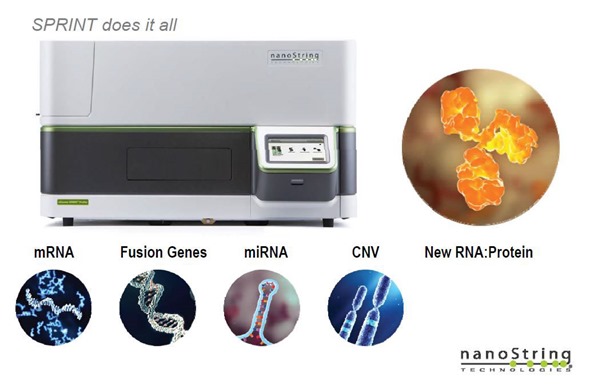
(c) 2016 NanoString Technologies, Inc.
nCounter SPRINT and nCounter MAX are for research use only. Not for use in diagnostic procedures.
Where can readers find more information?
http://www.nanostring.com/
About Dr Joseph Beechem
SVP of R&D, NanoString Technologies
Over 100 peer reviewed papers in diverse fields: biomathematics, physics, chemistry, physiology, spectroscopy, diagnostics, medicine and biology.
PhD in Biophysics from The Johns Hopkins University. Nearly equal experience in Academics (as a tenured faculty at Vanderbilt University) and Biotechnology (as Chief Science/Technology Officer for Invitrogen/LifeTech, SVP of R&D).
Lectured at almost every major medical/academic center in the USA/Europe/Japan) and pharmaceutical/biotechnology companies (worldwide).
Successful at new product introduction, patent inventions, building new departments (BioSciences and Corporate Res Lab), and large scale collaborative R&D programs. Ten-years of experience building Next-Gen Sequencers for Life Technology.
Currently leads a multidisciplinary team at NanoString (Seattle WA) using digital optical barcodes for the multiplexed counting of nucleic acids and proteins.
Recently introduced multiple 770-gene panels focused on taking very small amounts of clinical samples and resolving complete cancer driver pathway mapping and cancer immune response profiling.